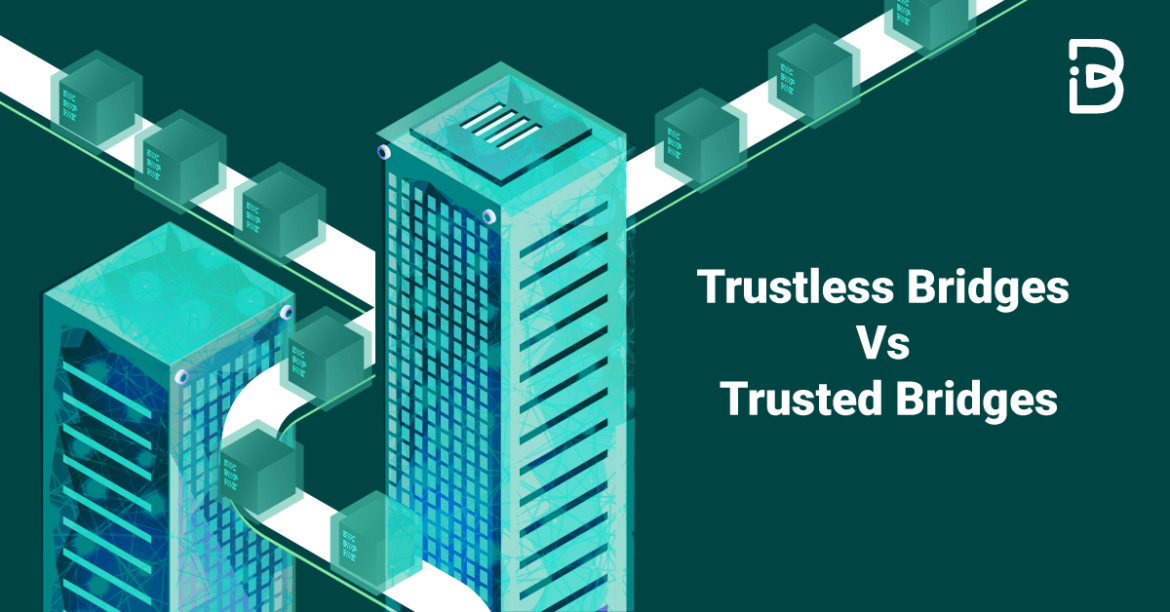Introduction
Table of Contents
Blockchain technology has given us many avant-garde ideas, such as trustless bridges. These bridges enable smooth interoperability and communication across various blockchain networks.
It does raise the question of whether or not trustless bridges are more secure than trustworthy ones. If they are, why aren’t they being used by everyone? We’ll delve deeper into the world of trustless bridges and delve into these issues in this blog article.
What are Trustless Bridges?
Before we dive into the safety of trustless bridges, let’s first understand what they are. Trustless bridges are a type of decentralized technology that connects two different blockchain networks. They work without the need for a trusted intermediary, such as a centralized exchange, to facilitate the transaction.
In other words, trustless bridges allow users to transfer assets between two blockchain networks without relying on a third party to hold or manage the assets. This makes the transaction faster and cheaper, as it eliminates the need for additional fees and the time required for third-party verification.
Bridges have become a necessary component of the blockchain industry because, as it stands, blockchains operate in silos and cannot communicate with one another.
Users cannot, for instance, utilize ether (ETH) on the Ethereum blockchain or Bitcoin (BTC) on the Ethereum blockchain. However, if a user (let’s call him Billy) wishes to pay another user (let’s call her Ethel) for something, but Ethel only accepts ETH, Billy runs into a problem. Ethel cannot receive Bitcoin from him directly.
BTC cannot be transmitted straight to Ethel, but he can take further measures to purchase ETH or exchange some of his BTC for ETH. In contrast to fiat currencies and credit cards, which can be used with a variety of providers, this might be considered a significant drawback.
Blockchain bridges are designed to solve this problem. While each blockchain bridge is designed differently, these bridges typically allow users to lock in a certain amount of digital assets on one blockchain. In exchange, the protocol will then credit or mint the same amount of assets on another blockchain, equivalent to the funds that are locked in.
Trust-based vs. Trustless Blockchain Bridges
From a security viewpoint, bridges can be classified into two main groups: trusted (also known as custodial) and trustless (noncustodial).
Trusted platforms are essentially platforms that rely on third parties to validate transactions while acting as custodians of the bridged assets. For example, all wrapped Bitcoin is held in custody by BitGo. Having one company control all of an asset means it is a single point of failure. If the company is corrupt, goes bankrupt, or has other fundamental problems, the crypto that it has in custody is at risk.
To give an example, the Ronin Bridge protocol required nine validators, of which the Sky Mavis team possessed four. The bulk of these validator nodes (five or more nodes) are necessary for the Ronin Bridge to initiate any withdrawal or deposit in order to preserve its security.
However, the attackers only required one more node to seize control because they were able to breach all four of the nodes that the Sky Mavis team was in control of. By doing this, they were able to remove $625 million from the protocol under the guise of a “verified” withdrawal.
Binance Bridge, Polygon POS Bridge, Avalanche Bridge, Harmony Bridge, and Terra Shuttle Bridge are more instances of trust-based bridges.
Platforms that exclusively use algorithms and smart contracts to store custody assets are referred to as trustless bridges, on the other hand. The integrity of its underlying code is where its restrictions lie.
Wormhole, for instance, is a platform that enables cross-bridge transactions between Ethereum and Solana. In February 2022, a flaw in the smart contract led to an exploit of the Wormhole blockchain bridge technology. As a result, the attackers were able to evade its verification procedures, leading to a compromise valued at approximately $326 million.
The Rainbow Bridge, Polkadot’s Snowbridge, and Cosmos IBC are other instances of trustless bridges.
Are Trustless Bridges Safer?
The question of whether trustless bridges are safer than trusted bridges is not an easy one to answer. While trustless bridges eliminate the need for a centralized intermediary, they come with their own set of risks and challenges. One of the most significant risks associated with trustless bridges is the possibility of a smart contract failure.
Smart contracts are self-executing contracts with the terms of the agreement directly written into the code.
While they provide a level of security and transparency, they can be vulnerable to bugs or hacks. If a smart contract is hacked or contains an error, it could result in the loss of funds or other assets.
On the other hand, trusted bridges are overseen by a centralized intermediary, such as a centralized exchange, which can provide an additional layer of security.
These intermediaries often have robust security measures in place, which can help to prevent hacks and other security breaches.
Why are Trustless Bridges Not Implemented Universally?
Despite the potential benefits of trustless bridges, they are not yet implemented universally. There are several reasons for this. One reason is the complexity of the technology.
Trustless bridges are still in their early stages of development, and as such, there are many technical challenges that need to be addressed.
Another reason is the lack of standardization. Different blockchain networks have different protocols and standards, which can make it difficult to create a single trustless bridge that can work with all networks.
Lastly, regulatory concerns are also a significant factor in the adoption of trustless bridges. Many governments around the world have yet to develop clear regulations around blockchain technology, which can make it difficult for companies and organizations to adopt new technologies such as trustless bridges.
Conclusion
Trustless bridges are an exciting and innovative concept in the world of blockchain technology. They offer a faster and cheaper way to transfer assets between different blockchain networks without relying on a centralized intermediary. While they come with their own set of risks and challenges, they have the potential to revolutionize the way we interact with different blockchain networks.
Despite their potential benefits, trustless bridges are not yet implemented universally due to technical complexity, lack of standardization, and regulatory concerns. As the technology continues to evolve and mature, it will be interesting to see how trustless bridges will be adopted and integrated into the wider blockchain ecosystem.

